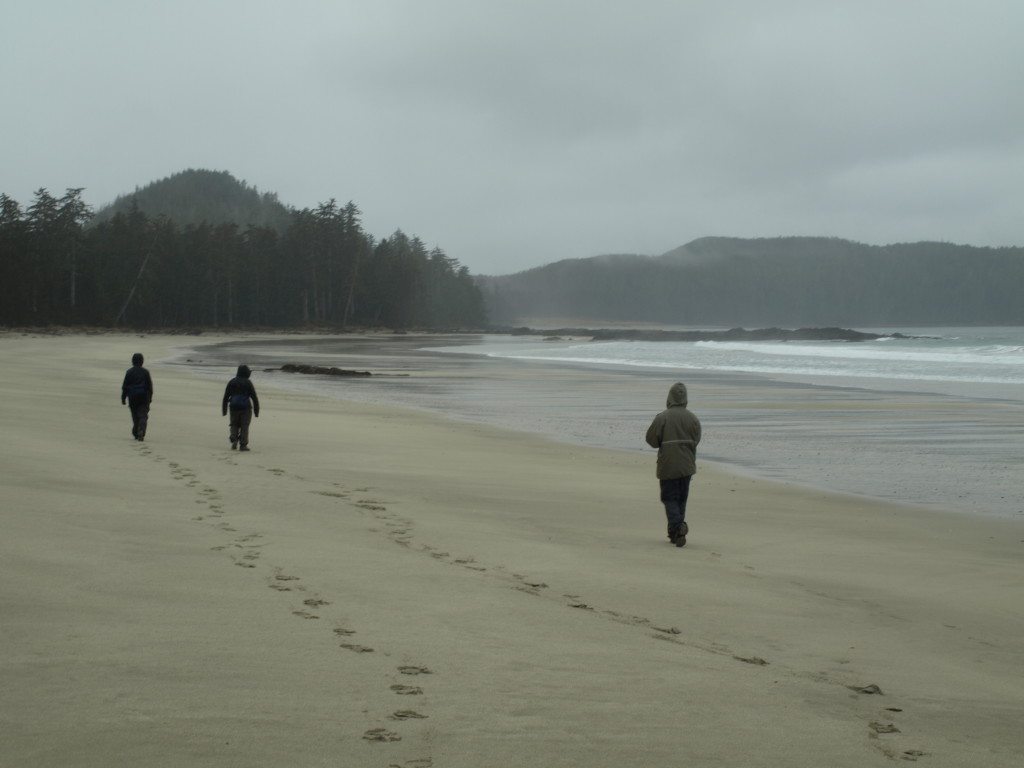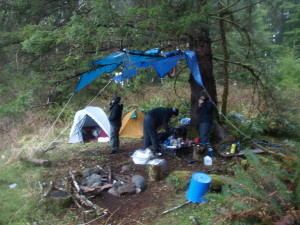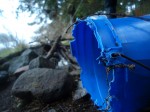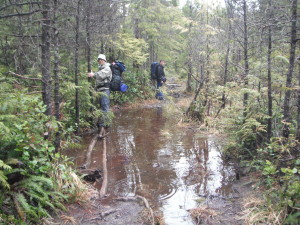Cape Scott Trail
Location: West coast of Vancouver Island, B.C., Canada
Date of trek: April, 2011
Duration/total distance: three days/45 kilometres
STORY AND PHOTOS BY DUSTIN WALKER
Shawneen and I huddled under the tarp, shovelling spoonfuls of warm maccaroni into our mouths. We should have been in the tent by now.
The wind came charging over the ocean, pounding our camp and swaying the fat cedars that towered over us. The propane-fed flame on our tiny stove kept blowing out, so we had to cook our dinner in a bear locker before taking shelter to eat. The wind was tough, but the rain was worse. Relentless. It eventually found a way to moisten the dry clothes underneath our rain gear and then chill the flesh underneath that.
We didn’t savour our meal. After a few more trembling bites, I stood up and let a strong gust snatch the tarp away. We piled into our tent, changed clothes and spent the next five hours listening to the bellowing wind. The creaking trees. The sound of tiny footsteps outside our tent.
***
Vancouver Island’s Cape Scott Trail offers incredible scenery and takes trekkers through some unique historical sites. But it also spans one of the wettest region’s of B.C.’s west coast.
My biologist wife Shawneen, along with her sister Sherree and her husband Chad, sloshed along this route in early April. Other than the lighthouse keeper at Cape Scott, we saw one other person the entire time (a twenty-something adventurer who was holed up in a cabin about 10 kilometres from where we camped, but that’s another story).
We dealt with some rain on day one as we hiked 15 kilometres of slippery boardwalk – dotted with wolf droppings – and muddy trails toward Nissen Bight. Massive trees had collapsed during recent winter storms, busting up sections of the boardwalk. We had to devise some unique detours, squeezing under fallen logs and pressing through thick sections of brush, to keep on track. Most of the Cape Scott Trail is flat, so these obstacles were probably the most physically challenging aspect of the hike. Once at Nissen Bight, we set up our tents and tried to light a fire. No luck. The wood was far too water-logged. With just a sprinkle of rain falling, we fell asleep still with relatively high spirits.
‘Crazy hikers’ on a flooded trail
Morale dropped when we awoke. The rain had picked up, casting a moment of doubt on our plan to hike the roughly 15-kilometre round-trip to the Cape Scott Lighthouse. But we pressed on. Part of the trail took us past rusted bits of history: an old saw blade, a few giant cogs. These were remnants of the Danish pioneers who had attempted to settle the area at the turn of the century.
A few hours into the slog, the skies really opened up. We trudged along the smooth sands of Experiment Bight as waves crashed against the shore. The cold and damp started to set in. After a few more tough kilometres, we arrived at the lighthouse. Shivering and sniffling.
“Whoa, crazy hikers,” said the thirty-something lighthouse keeper after answering the door. He directed us toward a greenhouse where we could seek shelter – not quite a cozy living room, but we were in no position to argue. We dried off a bit and eat, not looking forward to the hike back.
We picked up our pace and the rain did the same. Sections of the path that had previously been only muddy were now crossed by rapid streams or were partially flooded. Cold and exhausted, we finally trudged into our camp. With creative cooking techniques, we were able to scarf down some food and crawl into our tent by 8 p.m. Then we waited, hoping that the fierce wind wouldn’t tear open a tent or push a tree on top of us during the night. We listened to rustling in the nearby bushes and hoped it was just a deer. But that noise wasn’t the most pressing issue on our minds. Shawneen and I fell asleep worried that the storm wouldn’t let up; that we would have to cook breakfast and pack up our gear in a heavy downpour the next morning.
Close encounter in the woods
Sunshine busted up the grey skies when we awoke. Shawneen and I bounced out of our tent and started packing up, allowing our travelling companions to sleep a little longer. I started off toward the bear locker to get our food, anxious to hit the trail, when Shawneen handed me the hatchet.
“You should take this,” she said. I nodded, remembering the rustling we had heard last night. It’s always wise to trust a biologist’s instincts on these things.
I half-jogged into the bushes, my mind filled with thoughts of the oatmeal to come. Branches snapped somewhere nearby. I skidded to a halt. A greyish-brown snout peeked out from the brush – no more than a metre or two away – and then it was gone. My heart raced and I scanned my surroundings for signs of any other wolves. One was manageable; a pack could be trouble. I returned to camp, glancing over my shoulder every few seconds. Once at the tents, I took one final look behind me: the wolf stared back.
Fortunately, it was a young creature, more curious than anything. A couple of well-aimed bear-bangers sent it scurrying away. But I couldn’t help watching the bushes as we packed up, just in case he had some friends out there. Waiting.
Not a single drop of rain fell on the way back, which was a well-deserved reward after yesterday’s storm. The past couple days had been tough, no question. But in return for enduring the rain and cold, we got to experience this popular trek in a way few other people have. And I think that’s worth a little bit of misery.
Getting there:
The stunning Cape Scott Trail is located about 65 kilometres west of Port Hardy on the northwest tip of Vancouver Island, Canada. To arrive at the trailhead, hikers must first drive along 67 kilometres of rubber-piercing logging roads. We had to deal with a flat tire on our drive out.
A few kilometres south of Port Hardy, turn onto Holberg Road and watch for signs for the Cape Scott Provincial Park. The road also winds through Holberg, a tiny village that offers some supplies. The province’s website offers more details on the park.
Do you prefer the trails less travelled?
Join like-minded trekkers by signing up for the S&TT e-mail list. Every week, you’ll get:
- Profiles of little-known hiking destinations
- Gear reviews for backpackers and hikers
- Feature articles on strange and off-beat hiking
Plus we’re 100% spam-free (and proud of it)






